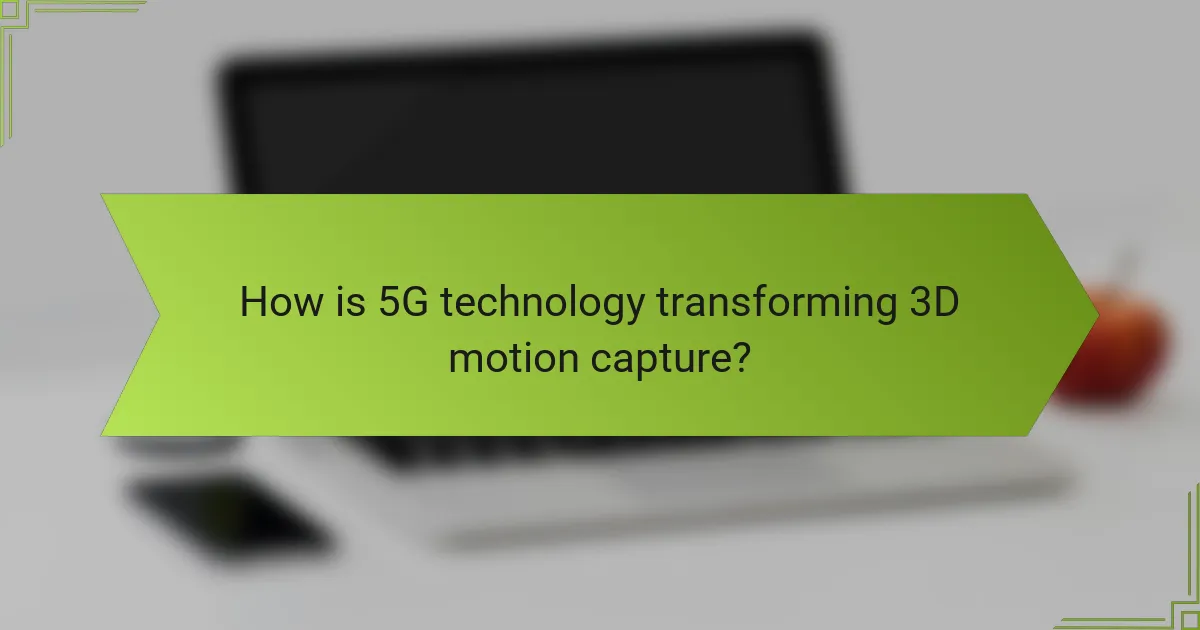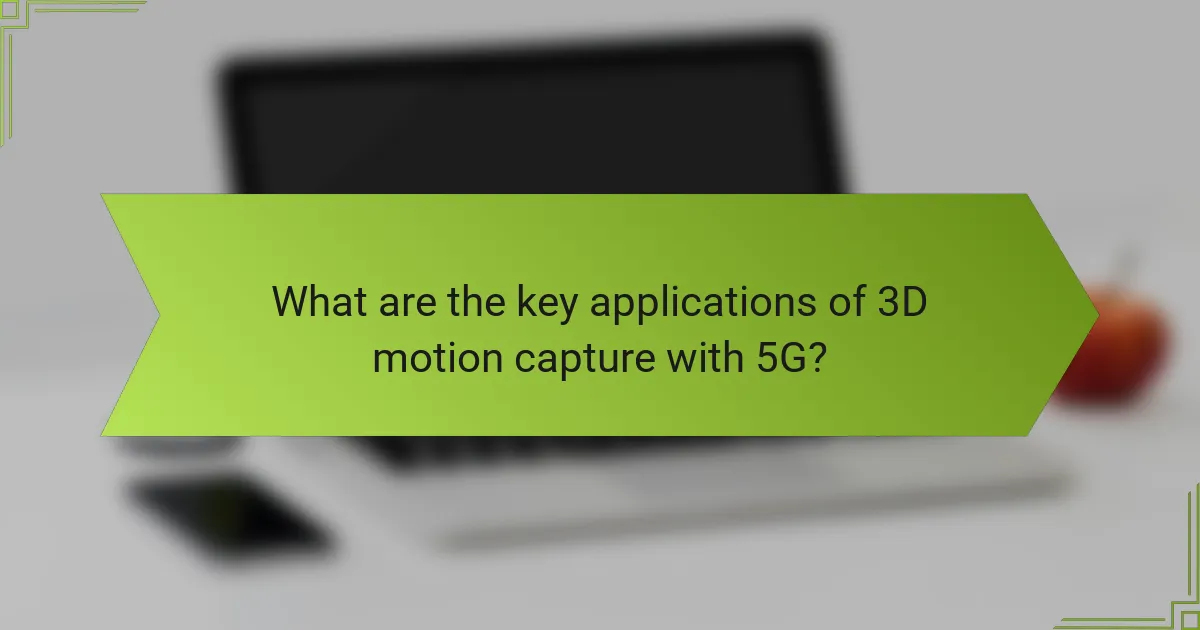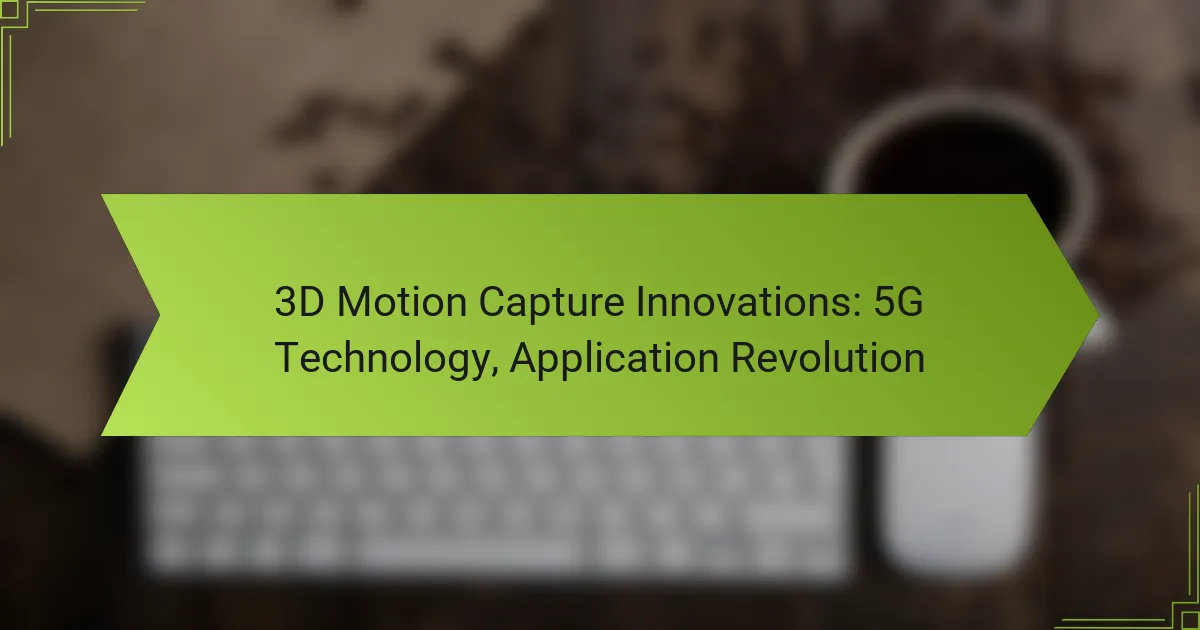5G technology is transforming 3D motion capture by providing faster data transmission, lower latency, and improved connectivity. This innovation enables real-time applications across various sectors, including entertainment, sports, and healthcare, significantly enhancing accuracy and engagement in these fields.

How is 5G technology transforming 3D motion capture?
5G technology is revolutionizing 3D motion capture by enabling faster data transmission, lower latency, and enhanced connectivity. These advancements allow for more accurate and real-time applications in various industries, including entertainment, sports, and healthcare.
Enhanced data transfer speeds
5G networks provide significantly higher data transfer speeds compared to previous generations, often exceeding 1 Gbps. This increase allows for the transmission of high-resolution motion capture data in real-time, which is crucial for applications like virtual reality and gaming.
For instance, capturing detailed movements in a live performance can now be done seamlessly, reducing the need for extensive post-processing. This capability enhances the overall quality of the output and allows for immediate feedback and adjustments during production.
Reduced latency for real-time applications
One of the standout features of 5G is its low latency, often around 1 millisecond. This reduction in delay is vital for real-time applications, such as live broadcasts or interactive gaming, where even slight lags can disrupt the experience.
With 5G, motion capture systems can respond instantly to movements, making it possible to create immersive environments where users feel fully engaged. This technology is particularly beneficial in industries like esports, where split-second decisions can determine outcomes.
Improved connectivity for remote collaboration
5G enhances connectivity, allowing multiple users to collaborate remotely on motion capture projects without compromising quality. This is especially useful for teams spread across different locations, as they can share and analyze data in real-time.
For example, a motion capture session can be streamed live to remote experts who can provide immediate feedback or adjustments. This capability not only saves time but also reduces costs associated with travel and logistics, making it easier for global teams to work together effectively.

What are the key applications of 3D motion capture with 5G?
3D motion capture technology combined with 5G enhances various fields by enabling real-time data transmission and improved accuracy. This synergy allows for groundbreaking applications in entertainment, healthcare, and sports, transforming how professionals operate and engage with their audiences.
Film and gaming industry advancements
The film and gaming industries have seen significant improvements through 3D motion capture powered by 5G. This technology allows for seamless integration of real-time animations and character movements, enhancing the overall visual experience. For instance, filmmakers can capture performances on set and instantly see the results, streamlining the production process.
Moreover, gaming developers can utilize 5G’s low latency to create immersive environments where players’ movements are reflected in real-time. This leads to more engaging gameplay and a heightened sense of presence, making virtual experiences feel more authentic.
Healthcare and rehabilitation innovations
In healthcare, 3D motion capture with 5G is revolutionizing rehabilitation practices. Therapists can monitor patients’ movements remotely, allowing for real-time feedback and adjustments to treatment plans. This immediate data transmission enhances the effectiveness of rehabilitation exercises, leading to quicker recovery times.
Additionally, 3D motion capture can assist in pre-surgical planning by providing detailed movement analysis. Surgeons can visualize a patient’s biomechanics, improving surgical outcomes and minimizing risks associated with procedures.
Sports performance analysis
Sports professionals are leveraging 3D motion capture technology to analyze athletes’ performance in unprecedented ways. With 5G, coaches can receive instantaneous data on an athlete’s movements, enabling them to make real-time adjustments during training sessions. This capability helps in fine-tuning techniques and maximizing performance.
Furthermore, teams can use this technology to assess injury risks by analyzing biomechanics. By identifying movement patterns that may lead to injuries, coaches can implement preventative measures, ultimately extending athletes’ careers and enhancing team performance.

Which companies are leading 3D motion capture innovations?
Several companies are at the forefront of 3D motion capture innovations, particularly with the integration of 5G technology. Vicon, Motion Analysis Corporation, and OptiTrack are notable leaders, each contributing unique advancements that enhance motion capture capabilities and applications.
Vicon’s latest 5G solutions
Vicon has developed cutting-edge 5G solutions that significantly improve data transmission speeds and reliability for motion capture systems. By leveraging 5G networks, Vicon enables real-time data streaming, which is crucial for applications in gaming, film, and virtual reality.
These advancements allow for seamless integration of motion capture data into live environments, reducing latency to low tens of milliseconds. This capability is particularly beneficial for live performances and interactive experiences where immediate feedback is essential.
Motion Analysis Corporation’s advancements
Motion Analysis Corporation is enhancing its motion capture technology with 5G by focusing on high-definition data capture and processing. Their systems are designed to handle large volumes of data efficiently, which is vital for detailed analysis in sports science and biomechanics.
With 5G, Motion Analysis Corporation can offer solutions that support multiple cameras and sensors working in tandem, allowing for comprehensive motion tracking in real-time. This innovation opens new avenues for research and development in various fields, including rehabilitation and athletic training.
OptiTrack’s integration with 5G
OptiTrack is integrating 5G technology into its motion capture systems to enhance the accuracy and responsiveness of its tracking solutions. This integration facilitates faster data transfer rates, enabling users to capture and analyze motion data without delays.
By utilizing 5G, OptiTrack’s systems can support complex environments with numerous moving elements, making them ideal for applications in film production and virtual simulations. The increased bandwidth also allows for higher resolution data, improving the overall quality of motion capture outputs.

What are the benefits of using 5G in motion capture?
5G technology significantly enhances motion capture by providing faster data transmission, lower latency, and improved connectivity. These benefits lead to more accurate and real-time motion tracking, which is crucial for industries like gaming, film, and virtual reality.
Higher accuracy in data collection
5G enables higher accuracy in data collection for motion capture systems by reducing latency to single-digit milliseconds. This rapid data transfer allows for precise synchronization between motion sensors and recording devices, resulting in more reliable and detailed motion data.
For example, in film production, this enhanced accuracy can lead to more lifelike character animations, as the nuances of an actor’s performance are captured without distortion or delay. The improved fidelity of motion data can elevate the overall quality of the final product.
Greater flexibility in motion tracking
The flexibility offered by 5G in motion tracking allows for a wider range of applications and environments. With its high bandwidth, motion capture systems can operate wirelessly over larger areas, enabling tracking in diverse settings without the constraints of wired connections.
This flexibility is particularly beneficial in live events or outdoor shoots, where traditional setups may be impractical. Creators can now capture dynamic movements in real-time, facilitating spontaneous and creative performances that were previously challenging to achieve.
Scalability for large-scale projects
5G technology supports scalability for large-scale motion capture projects by accommodating multiple devices and sensors simultaneously. This capability is essential for projects that require extensive coverage, such as video games with expansive environments or films with large ensemble casts.
For instance, a production team can deploy numerous motion capture suits across a vast area, all feeding data back to a central system without overwhelming the network. This scalability allows for more complex scenes and interactions, enhancing the storytelling experience.

What challenges exist in implementing 5G for motion capture?
Implementing 5G technology for motion capture presents several challenges, including infrastructure development, cost implications, and regulatory issues. These factors can significantly affect the deployment and effectiveness of motion capture systems in various environments.
Infrastructure development requirements
5G technology requires a robust infrastructure, including new base stations and fiber-optic networks to support high-speed data transmission. This can be particularly challenging in rural or less developed areas where existing telecommunications infrastructure is limited.
Studios looking to adopt 5G must assess their current infrastructure and determine what upgrades are necessary. Collaboration with local telecom providers can help streamline this process and ensure compatibility with existing systems.
Cost considerations for studios
The transition to 5G can involve significant costs for studios, including expenses related to equipment upgrades, installation, and ongoing maintenance. While the long-term benefits may justify these costs, studios must carefully evaluate their budgets and potential return on investment.
For many studios, exploring financing options or partnerships with technology providers can help mitigate upfront costs. Additionally, considering the scalability of 5G solutions can lead to more manageable financial commitments over time.
Regulatory hurdles in different regions
Different regions may have varying regulations regarding the deployment of 5G technology, which can complicate implementation for motion capture. Studios must navigate these regulations to ensure compliance and avoid potential legal issues.
It is essential for studios to stay informed about local telecommunications laws and work closely with legal advisors to address any regulatory challenges. Engaging with industry associations can also provide valuable insights into best practices and compliance strategies.

How can businesses choose the right 3D motion capture solution?
Businesses can choose the right 3D motion capture solution by assessing their specific needs, budget, and the intended application. Key factors include the technology’s accuracy, ease of use, and integration capabilities with existing systems.
Assessing business needs and goals
Start by identifying the primary objectives for using 3D motion capture. Whether for gaming, film production, or virtual reality, each application has unique requirements. Understanding these goals will guide the selection process.
Consider the scale of the project and the level of detail required. For instance, high-end film productions may need more sophisticated systems compared to smaller gaming projects. This assessment helps narrow down the options effectively.
Evaluating technology options
Different technologies, such as optical, inertial, and markerless systems, offer varying benefits. Optical systems provide high accuracy but may require controlled environments, while inertial systems are more portable and easier to set up.
Research the latest innovations in 3D motion capture, especially those leveraging 5G technology for real-time data transmission. This can enhance performance and reduce latency, which is crucial for applications like live events or interactive gaming.
Budget considerations
Establish a budget that accounts for both initial investment and ongoing costs. Prices for 3D motion capture solutions can vary widely, from a few thousand to tens of thousands of dollars depending on the technology and features.
Factor in additional expenses such as software licenses, maintenance, and training. It’s often beneficial to consider leasing options or subscription models to manage costs effectively.
Integration with existing systems
Ensure that the chosen motion capture solution can seamlessly integrate with your current workflows and software. Compatibility with animation tools and game engines is essential for a smooth production process.
Consult with vendors about integration capabilities and seek demonstrations to evaluate how well the systems work together. This step can prevent costly delays and technical issues later on.
Testing and validation
Before finalizing a purchase, conduct thorough testing of the shortlisted solutions. This may involve pilot projects or trials to assess performance in real-world scenarios.
Gather feedback from team members who will use the technology to ensure it meets practical needs. Validation through hands-on experience can significantly influence the final decision.
